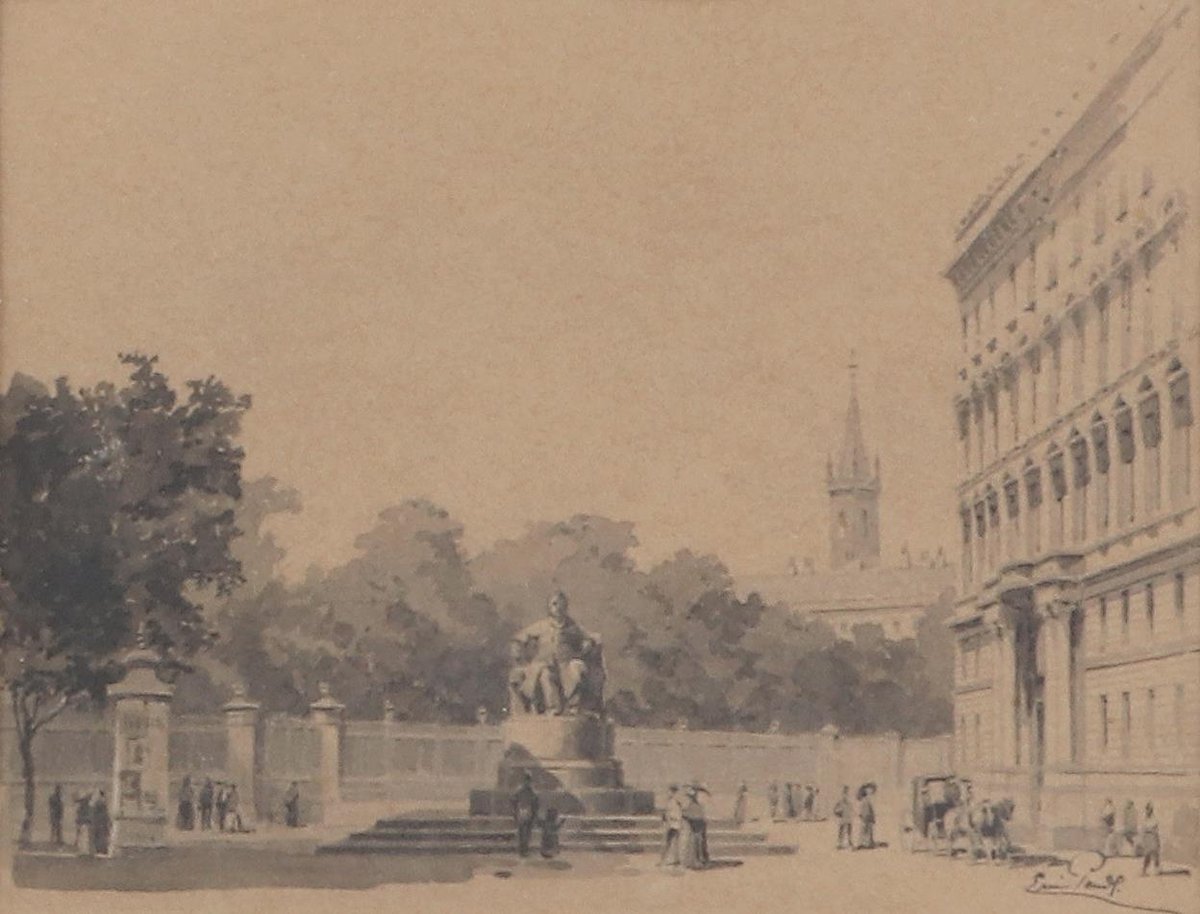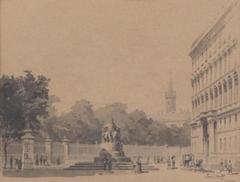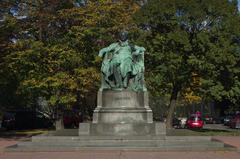
Visiting Goethe in Vienna: Hours, Tickets, and Tips
Date: 01/08/2024
Introduction
The Goethe Monument in Vienna, Austria, stands as a significant tribute to one of the most influential figures in German literature, Johann Wolfgang von Goethe. This comprehensive guide delves into the monument’s history, cultural importance, and practical visitor information, providing you with everything needed to make the most of your visit. Unveiled on December 15, 1900, by Emperor Franz Joseph, the monument is a testament to Vienna’s commitment to celebrating literary and cultural icons. Designed by the renowned sculptor Edmund Hellmer, the monument’s simplicity and focus on Goethe himself have been widely praised, including by the Emperor during the unveiling ceremony (Visiting Vienna). Funded through a two-decade-long campaign by the Vienna Goethe Association, the monument’s creation saw contributions from various sources, including the Imperial family and the court theatre, reflecting the high level of public and official support for the arts (Visiting Vienna). Strategically located at one end of Goethegasse, near the Albertina art museum and the Burggarten, the monument is part of a broader cultural landscape that includes numerous other historical and artistic sites (Visiting Vienna).
Table of Contents
- Introduction
- Historical Background
- The Unveiling of the Goethe Monument
- Fundraising and Contributions
- Location and Significance
- The Artistic and Cultural Context
- The Sculptor: Edmund Hellmer
- The Role of Emperor Franz Joseph
- The Burggarten and Surrounding Area
- Historical Photographs and Artistic Interpretations
- The Broader Cultural Landscape of Vienna
- Vienna’s Transformation Over the Decades
- Visitor Information
- Visual and Media
- FAQ Section
- Conclusion
Historical Background
The Unveiling of the Goethe Monument
The Goethe Monument in Vienna, Austria, was unveiled on December 15, 1900, by Emperor Franz Joseph. This event marked the culmination of over two decades of fundraising efforts led by the Vienna Goethe Association. The monument was designed by the sculptor Edmund Hellmer, who is also known for the famous Strauss memorial in Vienna’s Stadtpark. Hellmer’s design for the Goethe monument was deliberately simple, focusing on the figure of Goethe himself without excessive ornamentation. This approach was praised by Emperor Franz Joseph during the unveiling ceremony (Visiting Vienna).
Fundraising and Contributions
The fundraising campaign for the Goethe Monument was a significant effort that spanned more than 20 years. Contributions came from various sources, including members of the Imperial family and the court theatre, which donated money earned from performances of Goethe’s works. The unveiling ceremony was attended by thousands of bystanders and a who’s who of court society, reflecting the high level of public and official support for the project (Visiting Vienna).
Location and Significance
The Goethe Monument is strategically located in Vienna, sitting at one end of Goethegasse, a road named in honor of Johann Wolfgang von Goethe. This road stretches from just below the Albertina art museum in the old town to the Burggarten, a park behind the Neue Burg wing of the Hofburg palace complex. The monument itself is a seated bronze statue of Goethe in his 50s, reflecting a more relaxed and contemplative pose compared to other statues of historic figures in the city (Visiting Vienna).
The Artistic and Cultural Context
Vienna has a rich tradition of honoring literary and cultural figures through monuments and statues. The Goethe Monument is part of this tradition, standing in a sort of literary staring competition with the statue of Friedrich Schiller, another prominent German playwright and poet. Schiller’s statue is located about 180 meters away in Schillerpark, creating a symbolic dialogue between the two literary giants (Visiting Vienna).
The Sculptor: Edmund Hellmer
Edmund Hellmer, the sculptor of the Goethe Monument, was a prominent figure in the Viennese art scene. His decision to avoid excessive ornamentation in the Goethe statue was a deliberate artistic choice aimed at ensuring that the focus remained on Goethe himself. Hellmer’s work on the Strauss memorial in Stadtpark is another example of his significant contributions to Vienna’s cultural landscape (Visiting Vienna).
The Role of Emperor Franz Joseph
Emperor Franz Joseph played a crucial role in the unveiling of the Goethe Monument. His involvement in the ceremony and his praise for Hellmer’s design highlight the importance of the monument in the cultural and political context of the time. The Emperor’s participation also underscores the broader support for the arts and literature in Vienna during his reign (Visiting Vienna).
The Burggarten and Surrounding Area
The Goethe Monument is located near the entrance to the Burggarten, a beautiful park that features other notable statues, including those of Emperor Franz Joseph and Mozart. The Burggarten is part of the larger Hofburg palace complex, which has historical significance as the former imperial residence of the Habsburg dynasty. The park also occasionally hosts the stallions of the Spanish Riding School in small outdoor paddocks, adding to its cultural and historical appeal (Visiting Vienna).
Historical Photographs and Artistic Interpretations
Historical photographs and artistic interpretations of the Goethe Monument and its surroundings provide valuable insights into its historical context. For example, a photograph from around 1880 shows the view of Goethegasse, Palais Schey, and the future location of the Goethe monument. Additionally, Otto Wagner’s 1889 sketch imagines an alternative location and design for the monument, reflecting the artistic and architectural debates of the time (Visiting Vienna).
The Broader Cultural Landscape of Vienna
The Goethe Monument is part of Vienna’s broader cultural landscape, which includes numerous other monuments, museums, and historical sites. For example, the Hofburg Palace, the Schönbrunn Palace, and St. Stephen’s Cathedral are all significant attractions that reflect Vienna’s rich imperial and cultural history. The city’s coffeehouse culture, recognized by UNESCO as an Intangible Cultural Heritage, also adds to its unique cultural atmosphere (Versed Traveler).
Vienna’s Transformation Over the Decades
Over the decades, Vienna has transformed from a stiff capital city to a vibrant, hip, and arty paradise. This transformation is reflected in the city’s numerous museums, palaces, markets, restaurants, and art exhibits. The Goethe Monument, as part of this evolving cultural landscape, continues to attract visitors and serves as a reminder of Vienna’s rich literary and artistic heritage (Nomadic Matt).
Visitor Information
Location and Accessibility
For visitors planning to see the Goethe Monument, it is conveniently located near Karlsplatz station, accessible via the U1, U2, and U4 subway lines. It is also situated between two tram stops on the Ring, Burgring, and Oper/Karlsplatz, served by the 1, 2, D, and 71 lines. The address for the monument is Goethegasse 3, 1010 Wien. Visitors can also explore the nearby Burggarten and other attractions in the Hofburg palace complex (Visiting Vienna).
Ticket Prices and Visiting Hours
The Goethe Monument is accessible 24/7 and does not require an entry fee. Visitors can enjoy the monument and its surroundings at any time, making it a convenient and cost-effective stop on a tour of Vienna’s historical sites.
Nearby Attractions and Travel Tips
While visiting the Goethe Monument, consider exploring nearby attractions such as the Albertina art museum, the Hofburg palace complex, and the Burggarten. To make the most of your visit, wear comfortable walking shoes and carry a map of Vienna’s central district for easy navigation.
Special Features
Guided Tours
Some guided tours of Vienna’s historical sites include the Goethe Monument as a stop. These tours can provide additional insights into the monument’s history and significance.
Photographic Spots
The Goethe Monument offers several excellent spots for photography, particularly in the early morning or late afternoon when the light is soft. Capture the relaxed and contemplative pose of Goethe against the backdrop of Vienna’s architectural beauty.
Special Events
Occasionally, special events or cultural activities are held near the Goethe Monument and in the Burggarten. Keep an eye on local event listings to enhance your visit.
Visual and Media
(Here, you can add high-quality images or videos of the Goethe Monument with appropriate alt tags, such as “Goethe Monument Vienna” or “Goethe Monument statue.”)
FAQ Section
What are the visiting hours for the Goethe Monument?
The Goethe Monument is accessible 24/7, allowing visitors to explore it at any time.
Is there an entry fee to visit the Goethe Monument?
No, visiting the Goethe Monument is free of charge.
Can I join a guided tour that includes the Goethe Monument?
Yes, several guided tours of Vienna’s historical sites include the Goethe Monument as a stop.
What are some nearby attractions to the Goethe Monument?
Nearby attractions include the Albertina art museum, the Hofburg palace complex, and the Burggarten.
Conclusion
The Goethe Monument in Vienna is not just a tribute to one of the greatest figures in German literature but also a reflection of the city’s rich cultural and historical heritage. From its unveiling by Emperor Franz Joseph to its strategic location near the Burggarten and the Hofburg palace complex, the monument holds significant historical and cultural value. Visitors to Vienna can appreciate this monument as part of a broader exploration of the city’s numerous attractions and its vibrant cultural landscape. For more travel tips and updates, follow us on social media or check out our related posts (Versed Traveler).
References
- Visiting Vienna. (n.d.). Retrieved from Visiting Vienna
- Versed Traveler. (n.d.). Travel guide to Vienna. Retrieved from Versed Traveler
- Nomadic Matt. (n.d.). Austria travel guide. Retrieved from Nomadic Matt























































































































































